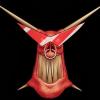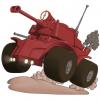- (Because of the issues with information overload that my previous threads regarding concept projects had, this thread will be broken into parts)
I may have mentioned a game called Somnion: Darkest Dreams in the past (most notably in the potential first game post). I also may have mentioned that I scoped it out to be similar to TES IV: Oblivion.
Well, after the concept began to crystallize fully, I redesigned that project; I looked for a smaller scope than even Oblivion and began to shift focus on several of the game's important elements. Today, I would like opinions regarding the gameplay designs I had in mind, as well as the game world (or worlds).
Somnion: Darkest Dreams is a sandbox RPG, albeit one built on a substantially lower budget than the industry norm (about 100,000$ is the estimated budget). As a result, the game makes up for it's lack of scope with unique features and a complex in-depth game system. Among these include that the game has a day/night cycle somewhat similar to the Persona series (especially 3) in which the player socializes and advances the plot during the day, but fights and explores during the night.
During the daytime, the player and the character they control can socialize with the residents of his town, make new friends which he can bring into the nighttime gameplay, and advance aspects of the plot. As the game is a sandbox RPG, the "waking world" depicted is quite large, with 13 hard-coded square miles of space.
In these sequences, the current character is controlled through third person (though a first-person view is used for the game's dialogue sequences).
Dialogue is another important part of Somnion. Unlike most other games, the dialogue sequences are interactive and play out similar to a point and click adventure rather than being another menu. The player navigates a cursor over objects in the world and presses an assigned button/key to trigger the dialogue advancement.
The waking world sequences affect the "Dream world" sequences in a variety of ways. First, the player can recruit characters they have befriended for expeditions into the dream world at night. in addition, the targeting mechanism (elaborated upon later) can be used to change a character's behavior in the waking world. there are also other links between the two times, such as sidequests that stretch into both worlds.
- segment questions:
- Budget: for a game with the graphical fidelity of FFXI on a high-definition emulator, a total size (from all the game worlds added up) about 43 square miles big (30 of said 43 square miles is procedurally generated), partial voice acting (mostly for main characters and special scenes), and a customization and character progression system leagues deeper than any TES title, is this a realistic estimate for how much the game will cost to develop?
- Day/Night cycle: I believe a common complaint for this idea is that some will feel as if this is like playing two games at once. Even though I plan to elaborate on this later, do any of you think this way currently?
- Dialogue system: simply put, Is in interesting or refreshing?
The nighttime gameplay is where the entirety of the game's combat takes place, as well as heavy amounts of exploration and customization. here, the player navigates through a world that is mostly procedurally generated, fighting enemies and advancing in power. the player can also alter a character's behavior in the waking world using the "Target" mechanic. this allows a player to affect a character in the dream world and change the behavior of their waking world counterpart. a good example would be the "FWTD" target mark, which allows a player to permanently kill a dream world character and drive the corresponding waking world character insane.
The dream world also features chained sidequests (similar to TES games) as well as one-off and radiant sidequests.
Finally, the game world is not a monolithic, uniform sandbox. Instead, the dream world is divided into self-contained zones that each feature their own biomes/inhabitants, appearance thematics, and items. Each of these five zones is completely independent form one another geographically and can only be accessed through fast travel (by way of teleportation) or through transportation services. The zones also vary in size.
- segment questions:
- day/night cycle: do any of you think it is an interesting, more involved mechanic that allows a player to have a greater effect on the game world, or are there still those who think that playing Somnion is still playing two games at once?
- game world: created due to budget constraints, the game world is not what makes this game a sandbox RPG (that would be the mechanical system, to be discussed in a future post). that being said, does anyone like this hub-network idea?
Other Questions:
- was something to vague or just left out? point it out.








